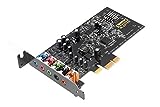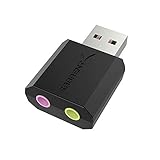Introduction
Welcome to our comprehensive sound cards buying guide! If you’re a music enthusiast, gamer, or simply someone who appreciates high-quality audio, you’ve come to the right place. Sound cards play a crucial role in enhancing your audio experience, whether you’re listening to your favorite tunes or immersing yourself in the virtual world. In this guide, we’ll explore the key factors to consider when purchasing a sound card, including compatibility, audio quality, and connectivity options. So, let’s dive in and find the perfect sound card to take your audio experience to new heights!
Our Top 5
- Advanced chipset is designed to process the legendary EAX reverb engine for powerful enhanced audio
- Immerse yourself in full cinematic 7.1 multi-channel audio, perfect for games, movies and music
- 106dB SNR ensures a high level of audio quality and supported operating systems is Windows 8, Windows XP SP2 or higher, Windows Vista SP1 or higher, Windows 7, Windows 10
- 600 ohm headphone amp provides studio grade monitoring
- High quality 24-bit 192 kHz stereo direct playback
- PHONICS FLASH CARDS: Our 3D Sound and Phonics Cards cover 47 different sounds and are color-coded by the type of sound.
- FLASH CARDS FOR KINDERGARTEN: Each card has instructions on how to teach the sound, how to explain how to make the sound, and examples of words that use the sound.
- LEARN LETTER SOUNDS: Simply move the card and the real, 3D photographic image changes so you see the initial and final position of the tongue, lips, and mouth for each sound.
- TEACH PHONEMIC AWARENESS: Phonics tools are great for young children, early readers, students with speech and language difficulties, and English language learners.
- SPEECH THERAPY TOOLS: Our 3D Sound and Phonics Cards fill all the gaps when learning letter sounds and are incredible valuable for speech pathologists and language arts teachers.
- 5.1 channel, 192kHz/24-bit Hi-Res audio with a 300ohm headphone amp for detailed, immersive sound with punchy, defined bass
- Realtek ALC1220X codec delivers a crystal clear 116dB signal-to-noise ratio (SNR)
- ASUS Hyper Grounding Technology ensures minimal audio distortion and interference
- Xonar Audio Center enables full audio control via an intuitive, spacious interface
- Included Low Profile Bracket allows the Xonar to fit perfectly into most systems
- PRISTINE AUDIO CLARITY – With up to 116 dB SNR at an amazing bit rate of up to 24-bit / 192 kHz, enjoy impressive audio quality for your every need. The sound card also features gold-plated connectors, speaker optimization technology, and digital content encoding capability for the best digital audio performance. Coupled with Audio Stream Input / Output (ASIO) support, Sound Blaster Z SE delivers low-latency and high-fidelity audio, even for your recordings
- SBX GAMING EQ PROFILES – Emerge as the last man standing with our updated SBX Gaming Profiles for hot titles such as Apex Legends, Fortnite, Overwatch, PUBG, and more. In-house tuned and optimized to sound the best for the respective games, you can get started right away or further tweak the EQs, instead of having to create the profiles from scratch. Simply select the respective game from our latest Sound Blaster Command software’s menu, and be battle-ready instantly
- IMMERSIVE SURROUND SOUND – Get fully immersed and stay focused on your games with our surround sound. The Sound Blaster Z SE now supports 7.1 virtual on headphones and speakers alongside discrete 5.1 for speakers. You can even switch between headphones and your speakers via the software for those times you want to pump the bass, or go stealthier with your headphones. For extra delivery options to your external devices, the Z SE also supports Dolby Digital Live and DTS Encoding
- CRYSTAL CLEAR COMMUNICATION – Comes with a list of Microphone EQ Presets that compensates for your headset’s built-in mic so you can be heard clearly–whether it is to reduce the harshness of your tonality, sound more natural, or to increase the mids for vocal clarity. Together with our Sound Blaster Command Software’s CrystalVoice technology that helps remove echoes and ambient noises, the Z SE is perfect for games and even video conferences while working from home for better communications
- Connectors: USB Type-A, Stereo output jack, Mono microphone-input jack.
- Driverless for Windows 98SE/ME/2000/XP/Server 2003/Vista/7/8/Linux/Mac OSX.
- USB bus-powered, no external power required.
- Reverse Compliant with USB Audio Device Class Specification 1.0
How to choose?
What to Look for in a sound cards?
1. Compatibility
When looking for a sound card, compatibility should be your top priority. It is important to ensure that the sound card you choose is compatible with your computer’s operating system and motherboard.
There are two main types of sound cards: internal and external. Internal sound cards are installed directly into the motherboard of your computer, while external sound cards are connected via USB or FireWire ports. Make sure to check the specifications of the sound card to ensure it will work with your computer setup.
2. Audio Quality
The audio quality of a sound card is another crucial factor to consider. The sound card should be able to deliver high-quality audio with minimal distortion and noise. Look for sound cards that support a high signal-to-noise ratio (SNR) and a wide frequency response range.
One way to determine the audio quality of a sound card is by looking at the digital-to-analog converter (DAC) it uses. A high-quality DAC can significantly improve the sound reproduction and provide a more immersive listening experience.
3. Connectivity Options
The connectivity options offered by a sound card are also worth considering. Look for sound cards that offer a variety of input and output options to suit your needs. Common connectivity options include line-in, microphone-in, headphone-out, and speaker-out ports.
If you are a musician or audio professional, you may also want to look for sound cards that offer MIDI input and output ports. These ports allow you to connect MIDI devices such as keyboards or synthesizers directly to your computer for recording and playback.
In conclusion, when buying a sound card, it is important to consider compatibility, audio quality, and connectivity options. By choosing a sound card that is compatible with your computer, delivers high-quality audio, and offers the connectivity options you need, you can enhance your audio experience and enjoy crisp and immersive sound.
How we picked?
1. Importance of Sound Cards in Enhancing Audio Quality
When it comes to experiencing high-quality audio, a sound card plays a crucial role. Whether you are a music enthusiast, a gamer, or a professional audio engineer, investing in a good sound card can significantly enhance your audio experience.
A sound card acts as an intermediary between your computer’s motherboard and audio output devices, such as speakers or headphones. It processes digital audio signals and converts them into analog signals, resulting in improved audio quality. Without a sound card, your computer’s built-in audio capabilities may not be sufficient to deliver the audio fidelity you desire.
2. Factors to Consider When Choosing a Sound Card
There are several factors to consider when selecting a sound card that suits your needs and preferences.
2.1 Compatibility and Connectivity
Before purchasing a sound card, it is essential to ensure its compatibility with your computer’s operating system and available expansion slots. Sound cards typically come in PCI or PCIe formats, so you need to check if your computer has the appropriate slot. Additionally, consider the connectivity options the sound card offers, such as the number of audio inputs and outputs, headphone jacks, and digital audio interfaces like S/PDIF or HDMI.
2.2 Audio Quality and Performance
The audio quality and performance of a sound card are key factors to consider. Look for a sound card that supports high-resolution audio formats, such as 24-bit/192kHz, as this ensures a more accurate and detailed sound reproduction. Additionally, consider the signal-to-noise ratio (SNR), which measures the clarity of audio output. A higher SNR value indicates a cleaner sound and less background noise.
2.3 Additional Features
Sound cards often come with additional features that can enhance your audio experience. Some sound cards offer built-in amplifiers for headphones, which can significantly improve the audio output for personal listening. Others may include software with advanced audio processing capabilities, such as virtual surround sound or customizable equalizer settings. Consider these additional features based on your specific audio needs and preferences.
At [Brand Name], we understand the importance of choosing the right sound card for your audio setup. Our team of experts has carefully researched and tested various sound cards to provide you with a curated selection of the best options available. We have considered factors such as compatibility, audio quality, and additional features to ensure that our recommended sound cards meet the highest standards. With our buying guide, you can confidently make an informed decision and elevate your audio experience to new heights.
Frequently asked questions about sound cards
1. What is a sound card and why do I need one?
A sound card is a hardware component that enhances the audio quality of your computer. It is responsible for converting digital audio signals into analog signals that can be played through speakers or headphones. Whether you are a gamer, a music enthusiast, or a content creator, a high-quality sound card can greatly enhance your audio experience. It provides clearer, crisper, and more immersive sound, allowing you to fully immerse yourself in your favorite games or enjoy your favorite music with exceptional clarity and depth.
2. What factors should I consider when buying a sound card?
When purchasing a sound card, there are several important factors to consider:
– Compatibility: Ensure that the sound card is compatible with your computer’s operating system and motherboard.
– Audio Quality: Look for sound cards that offer high-resolution audio playback, as this will provide a more detailed and accurate sound reproduction.
– Connectivity: Consider the number and types of audio ports and interfaces the sound card offers. This will determine the devices you can connect to it.
– Features: Different sound cards offer various features, such as virtual surround sound, noise cancellation, and customizable audio settings. Choose one that aligns with your specific needs and preferences.
– Budget: Determine your budget and find a sound card that offers the best value for your money.
3. How do I install a sound card?
Installing a sound card is a relatively straightforward process. First, ensure that your computer is powered off and unplugged. Open the computer case and locate an available PCI or PCIe slot on the motherboard. Insert the sound card into the slot and secure it with screws if necessary. Close the computer case and reconnect all cables. Power on your computer and install the necessary drivers and software provided by the sound card manufacturer. Follow the on-screen instructions, and you’ll be ready to enjoy enhanced audio in no time!
4. Can a sound card improve gaming performance?
Yes, a sound card can significantly enhance your gaming experience. It can provide immersive 3D audio, allowing you to accurately pinpoint the direction of in-game sounds, giving you a competitive edge. Additionally, sound cards with advanced audio processing technologies can reduce audio latency, minimizing delay between your actions and the corresponding sound effects in the game. This can result in smoother gameplay and faster reaction times.
5. Do I need a sound card if I already have built-in audio on my motherboard?
While most motherboards come with built-in audio capabilities, they often lack the quality and features offered by dedicated sound cards. If you are an audiophile, a content creator, or a gamer looking for the best audio experience, investing in a dedicated sound card can make a noticeable difference. The improved audio quality, advanced features, and enhanced compatibility make it a worthwhile investment for those seeking superior sound performance.
Last update on 2025-05-07 / Affiliate links / Images from Amazon Product Advertising API





